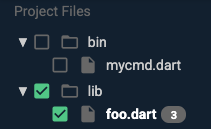Unsound null safety
Mixing language versions lets you migrate to null safety at your own pace, with some of the benefits of null safety.
A Dart program may contain some libraries that are null safe and some that aren't. These mixed-version programs rely on unsound null safety.
The ability to mix language versions frees package maintainers to migrate their code, with the knowledge that even legacy users can get new bug fixes and other improvements. However, mixed-version programs don't get all the advantages that null safety can bring.
This page describes the differences between sound and unsound null safety, with the goal of helping you decide when to migrate to null safety. After the conceptual discussion are instructions for migrating incrementally, followed by details on testing and running mixed-version programs.
Sound and unsound null safety
#Dart provides sound null safety through a combination of static and runtime checks. Each Dart library that opts in to null safety gets all the static checks, with stricter compile-time errors. This is true even in a mixed-version program that contains null-unsafe libraries. You start getting these benefits as soon as you start migrating some of your code to null safety.
However, a mixed-version program can't have the
runtime soundness guarantees that a fully null-safe app has.
It's possible for null to leak out of the null-unsafe libraries
into the null-safe code, because
preventing that would break the existing behavior of the unmigrated code.
To maintain runtime compatibility with legacy libraries while offering soundness to completely null-safe programs, Dart tools support two modes:
-
Mixed-version programs run with unsound null safety. It's possible for
nullreference errors to occur at runtime, but only because anullor nullable type escaped from some null-unsafe library and got into null-safe code. -
When a program is fully migrated and all its libraries are null safe, then it runs with sound null safety, with all of the guarantees and compiler optimizations that soundness enables.
Sound null safety is what you want if possible. Dart tools automatically run your program in sound mode if the main entrypoint library of your program has opted into null safety. If you import a null-unsafe library, the tools print a warning to let you know that they can only run with unsound null safety.
Migrating incrementally
#Because Dart supports mixed-version programs, you can migrate one library (generally one Dart file) at a time, while still being able to run your program and its tests.
We recommend that you first migrate leaf libraries—libraries that don't import other files from the package. Then migrate libraries that directly depend on the leaf libraries. End by migrating the libraries that have the most intra-package dependencies.
For example, say you have a lib/src/util.dart file
that imports other (null-safe) packages and core libraries,
but that doesn't have any import '<local_path>' directives.
Consider migrating util.dart first,
and then migrating files that depend only on util.dart.
If any libraries have cyclic imports
(for example, A imports B which imports C, and C imports A),
consider migrating those libraries together.
Using the migration tool
#
You can migrate incrementally using the
migration tool.
To opt out files or directories, click the green checkbox.
In the following screenshot,
all files in the bin directory are opted out.

Each opted out file will be unchanged
except for a 2.9 language version comment.
You can later run dart migrate again to continue the migration.
Any files that are already migrated feature a disabled checkbox:
you cannot un-migrate a file once it has been migrated.
Migrating by hand
#If you want to incrementally migrate a package by hand, follow these steps:
-
Edit the package's
pubspec.yamlfile, setting the minimum SDK constraint to at least2.12.0:yamlenvironment: sdk: '>=2.12.0 <3.0.0' -
Regenerate the package configuration file:
dart pub getRunning
dart pub getwith a lower SDK constraint of2.12.0sets the default language version of every library in the package to 2.12, opting them all in to null safety. -
Open the package in your IDE.
You're likely to see a lot of analysis errors. That's OK. -
Add a language version comment to the top of any Dart files that you don't want to consider during your current migration:
dart// @dart=2.9Using language version 2.9 for a library that's in a 2.12 package can reduce analysis errors (red squiggles) coming from unmigrated code. However, unsound null safety reduces the information the analyzer can use. For example, the analyzer might assume a parameter type is non-nullable, even though a 2.9 file might pass in a null value.
-
Migrate the code of each Dart file, using the analyzer to identify static errors.
Eliminate static errors by adding?,!,required, andlate, as needed.
Testing or running mixed-version programs
#To test or run mixed-version code, you need to disable sound null safety. You can do this in two ways:
-
Disable sound null safety using the
--no-sound-null-safetyflag to thedartorfluttercommand:dart --no-sound-null-safety run flutter run --no-sound-null-safety -
Alternatively, set the language version in the entrypoint—the file that contains
main()function—to 2.9. In Flutter apps, this file is often namedlib/main.dart. In command-line apps, this file is often namedbin/<packageName>.dart. You can also opt out files undertest, because they are also entrypoints. Example:dart// @dart=2.9 import 'src/my_app.dart'; void main() { //... }
Opting out tests using either of these mechanisms can be useful for testing during your incremental migration process, but doing so means that you aren't testing your code with full null safety enabled. It's important to opt your tests back in to null safety when you've finished the incremental migration of your libraries.
Unless stated otherwise, the documentation on this site reflects Dart 3.10.3. Page last updated on 2025-9-4. View source or report an issue.